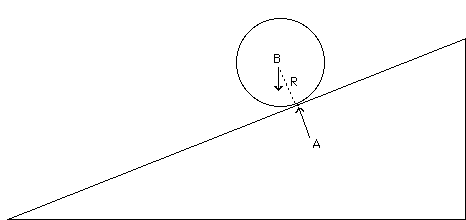
Of what advantage is assuming that psychic phenomena are lawful? Classification of objects and phenomena changes into problem solving through interaction analysis. What does it cost to assume that psychic phenomena are lawful? One must actually solve some problems. As a simple example of how great in practice the difference is between classification and interaction analysis, consider this caricature of what one might say about the situation below where a heavy ball descends on an inclined plane.
If given this situation and asked to explain what would happen and why the ball rolls to the left, what would one of Aristotle's students have said? Perhaps that the ball would roll down the slope because it was heavy, and heavy things, by their nature, fall. To clarify his meaning, he might have added that if the ball were one of fire, it would rise. The lighter things rise, the heavier sink, thats all; their nature explains their action. If one insisted that a significant question remains, that is, where the horizontal movement comes from, the budding aristotelian would make the obvious comment that the sphere rolled to the side because, as a matter of fact and chance, the slope was in the way (and he would judge you addled-pated for thinking there was something mysterious about THAT).

What would a student of Galileo do with this problem ? Observing that this is a problem of interactions -- not unimpeded motion -- he would note that the sphere is pushing down (from "B". its center of gravity) , and because the slope doesn't move, it must be pushing up, against the ball. The only place where they can push each other is the single point of contact, where the slope pushes on the sphere (perpendicularly to the surface). Although the sphere pushes the slope at the same point, its downward tendency acts more effectively (from B) to the left of the contact point In consequence, the two objects push each other "off center". This resulting off center push ("torque") cause the sphere to roll around the contact point. This torque continues to act even though the actual point of contact between sphere and slope changes from moment to moment, and the ball rolls down. The sideways motion is not an accident of something interfering with the natural tendency of the objects to reach their ends, but an immediate and lawful consequence of the specific way these two concrete objects push on each other.
Notice these aspects of the example. Classification -- lighter versus heavier -- becomes problem solving. Next, what the "Galilean" formulation sees as lawful was ascribed to chance interference by the "Aristotelian." Of the Galilean formulation, notice that one is concerned less with the motion of objects as such than with the interaction of an object and its environment. Further, the specific problem here is particular and a very special case of the more general problem of objects in motion. Finally, there has been no mention at all of quantification or mathematics. Greater precision through mathematical descriptions in modern science is important., but it is still secondary to the specific analysis of how an object interacts with its environment.
Why has learning not been successfully dealt with in the past as a collection of problems? Part of the excuse may be that learning presents very hard problems. The most obvious dimensions of difficulty are these:
learning is, by definition, a change of cognitive structure; once it happens, one can no longer re-establish the prior state of the subject's mind.
it is far from clear what is a good abstract representation of cognitive structure; consequently, to be specific, one must resort to particulars.
The mind is more complex than the simple problems which it confronts in typical psychological experiments; much effort needs to be invested in understanding a particular mind before one can address concretely how that mind interacts in detail with a specific problem setting.
Publication notes: